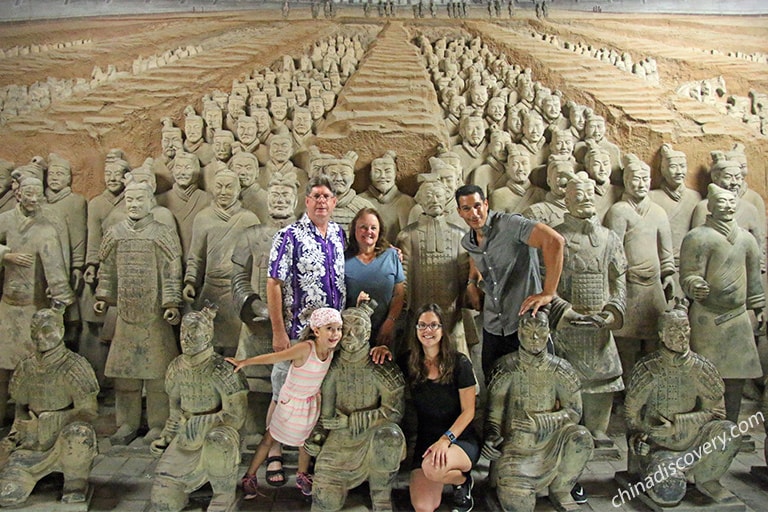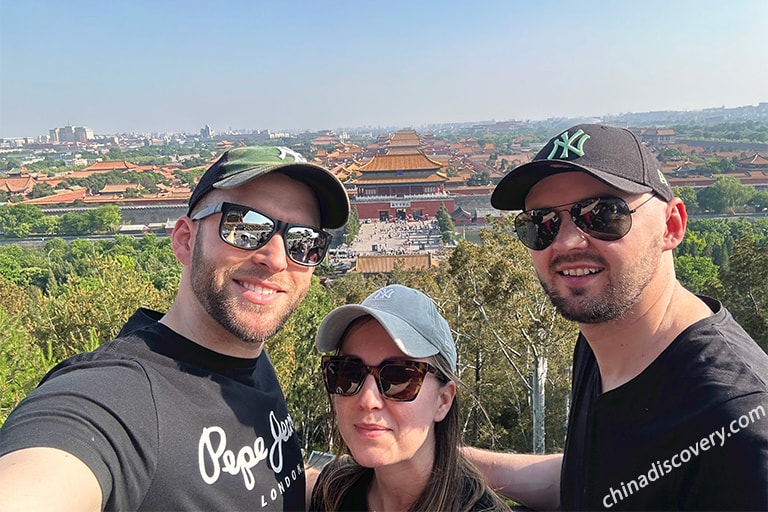What Treasures Are Collected in the Palace Museum (Forbidden City)
The Forbidden City, once as the imperial palace of China, is a sprawling complex brimming with history and art. Today, the main function of the Forbidden City, which renamed as the Palace Museum in 1925, is to serve as an open museum to showcase the lifestyle and artistic achievements of the ancient Chinese royal family to the public. Its over 1.8 million collection offers a captivating cultural journey through centuries of Chinese civilization.
Why are the Relics of the Palace Museum So Precious
The Palace Museum's collections are more than just treasures; they are living testaments to China's rich heritage. Each piece tells a story, from the grandeur of imperial power to the delicate artistry of skilled craftsmen.
Royal Collection: The vast majority of the cultural relics in the Palace Museum come from the collections of the royal families of the Ming and Qing dynasties, and their quantity, variety and artistic level are rare in the world.
Historical Witnesses: These artifacts are not only works of art, but also testimonies of history. They record all aspects of ancient Chinese court life, from the clothing, food, housing and transportation of the emperors to the tastes of the literati, from court etiquette to folk customs.
Exquisite craftsmanship: The craftsmanship of the cultural relics of the Palace Museum is exquisite, reflecting the wisdom and talent of ancient craftsmen. Whether it is bronze, ceramics, jade, lacquerware, weaving and embroidery, they have all reached the pinnacle of art.
Types of Cultural Relics in the Palace Museum
Imperial Porcelain: The collection boasts an exquisite array of porcelain, ranging from the understated elegance of Song dynasty celadon to the vibrant colors of Ming dynasty blue and white.
Bronze Masterpieces: Discover the awe-inspiring bronze artifacts, including ceremonial vessels, weapons, and sculptures, dating back to the Shang and Zhou dynasties.
Jade Carvings: Admire the intricate jade carvings, showcasing the Chinese mastery of this precious stone, from delicate ornaments to monumental sculptures.
Imperial Textiles: Explore the splendor of imperial textiles, including silk brocades, tapestries, and embroideries, adorned with intricate patterns and motifs.
Calligraphy and Painting: Immerse yourself in the world of Chinese calligraphy and painting, featuring works by renowned masters such as Wang Xizhi (王羲之), Li Bai (李白), and Wu Daozi (吴道子).
Highlights of the Palace Museum Collection
Whether you're a history enthusiast, an art lover, or simply curious about Chinese culture, the Forbidden City's cultural relics collection offers an unforgettable experience. The Gallery of Clocks of the Palace Museum has a large collection of antique clocks, where you can appreciate the superb craftsmanship of Chinese and foreign clocks; the Treasure Gallery of the Palace Museum represents the highest level of court craftsmanship in the Ming and Qing Dynasties, where you can appreciate various Chinese brilliant treasures; and there are also Gallery of Painting and Calligraphy, the Sculpture Gallery, the Ceramics Gallery, the Bronze Gallery, the Furniture Gallery, etc. As you wander through all the palace halls, surrounded by these magnificent artifacts, you'll gain a deeper appreciation for China's rich and complex past.
Silk Tapestry of the Assembly of Immortals at Jasper Lake (缂丝瑶池集庆图轴) - Ming dynasty
This work depicts a scene of the abode of the Queen Mother of the West (西王母) during her birthday celebration at Jasper Lake in the Western Paradise. The hanging scroll is more than two meters long, making it the largest extant silk tapestry of the Ming dynasty. The loom on which this elaborate work was created must have been enormous. Full of diverse imagery, the work is rare among the wide-range of silk tapestry works produced throughout Chinese art history. The composition is lavish in detail with a splendid arrangement of color. Consequently, the exquisite work would have been a suitable decoration for luxuriant birthday celebrations.
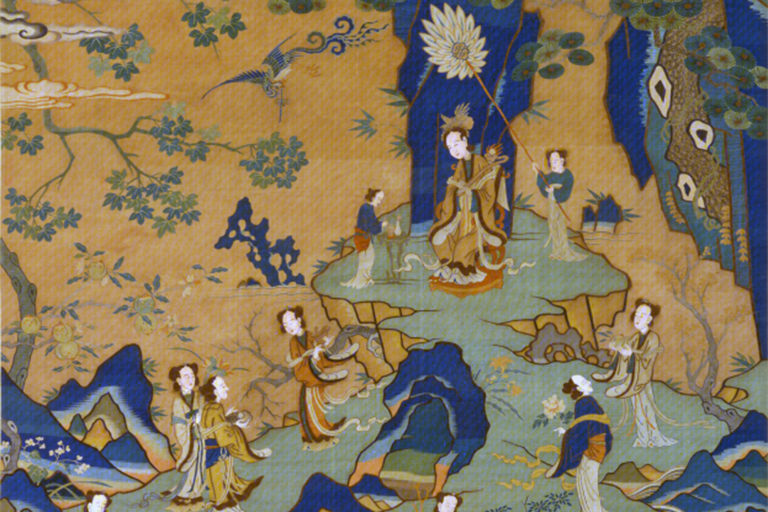 Silk Tapestry of the Assembly of Immortals at Jasper Lake
Silk Tapestry of the Assembly of Immortals at Jasper Lake©Palace Museum (https://intl.dpm.org.cn/)
Gilded Silver Armillary Sphere (银镀金浑仪) - Qing dynasty
The armillary sphere is formed by three sets of rings, one inside another. The horizon, meridian, and celestial equator rings constitute the outer layer, while the ecliptic, equatorial, and moon's-path rings form the middle layer. Gimbals comprise the inner layer. Each of the rings is graduated. In the middle of the fixed general axle is a small globe carved with the names of the five continents known at that time. At one end of the axle are images of the sun and moon and a small meter. The armillary sphere is designed to demonstrate how the sun and moon circle around the earth, the solar and lunar eclipses, and the movements of other heavenly bodies. The instrument was made during the Kangxi reign by the Jesuit Ferdinand Verbiest who served as a court astronomer and presented it to the court in the eighth year of Kangxi (1669).
 Gilded Silver Armillary Sphere
Gilded Silver Armillary Sphere©Palace Museum (https://intl.dpm.org.cn/)
Blue-and-white Celestial-sphere Vase with Underglaze-red Dragon-among-clouds Design and Qianlong Reign Mark (乾隆款青花釉里红云龙纹天球瓶) - Qing dynasty
An innovation by kiln artisans of the Yongle (1403-1424) and Xuande (1426-1435) reigns during the Ming dynasty (1368-1644), celestial-sphere vases are embellished primarily with blue designs. During the Yongzheng (1723-1735) and Qianlong (1736-1795) reigns of the Qing dynasty (1644-1911), variations in blue with underglaze red, contrasting colors, and famille rose were made. The elegant vase has a sturdy design - one rather commonly seen among ceramics made at official kilns during the Qianlong period. Positively reflecting the ancient Chinese concept of “clouds following the dragon”, the portrayal of the dragon with three sections of its body exposed while the rest is concealed behind clouds is a technique prevalent on works of the Shunzhi reign (1644-1661). The style of mottled clouds is seen most commonly on pieces from the same earlier period but was used during the subsequent Kangxi reign (1662-1722) and employed with enhanced realism during the Qianlong period.
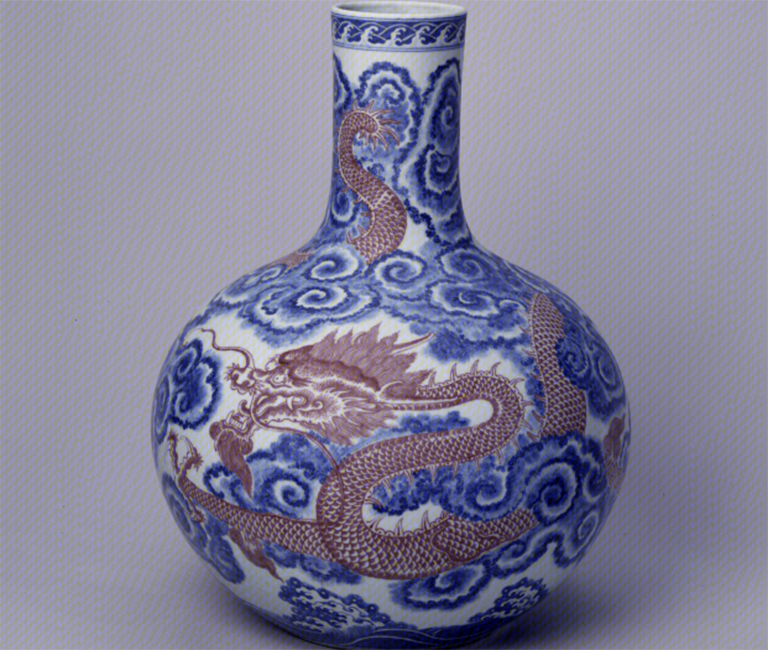 Blue-and-white Celestial-sphere Vase with Underglaze-red Dragon-among-clouds Design and Qianlong Reign Mark
Blue-and-white Celestial-sphere Vase with Underglaze-red Dragon-among-clouds Design and Qianlong Reign Mark©Palace Museum (https://intl.dpm.org.cn/)
Golden Bell Chimes (金编钟-林钟) - Qing dynasty
Belonging to the category of metal instruments of the traditional eight tones, bell chimes were important ritual instruments in court musical ensembles since the pre-Qin period and throughout China’s dynastic history. In the imperial courts of the Ming and Qing dynasties, they were played exclusively for ritual sacrifices at temples and altars and during court ceremonies as part of official harmonious music arrangements, which signified the status of the gods of heaven and earth and supreme imperial authority. Made at exorbitant cost, this set of golden bell chimes was cast with a composition of forty percent gold, at over 10,000 taels, while the surface was gold plated five times and gilded with tens of taels of pure gold leaf.
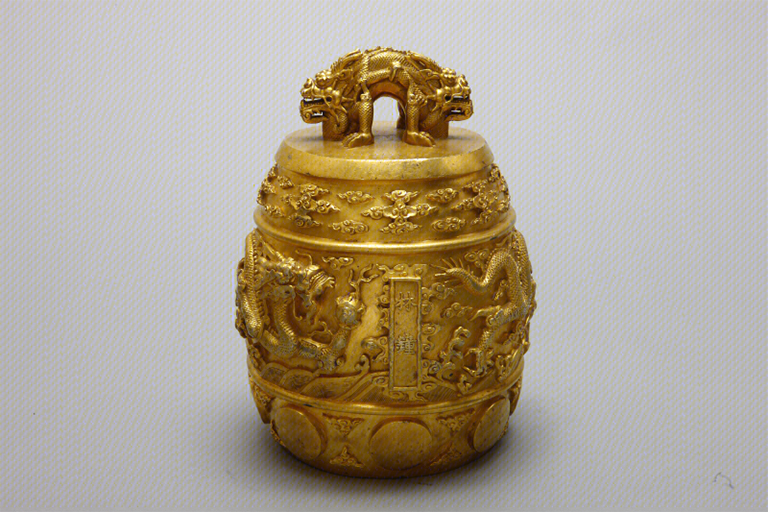 Golden Bell Chimes
Golden Bell Chimes©Palace Museum (https://intl.dpm.org.cn/)
Carved Red Lacquer Box with Dragons Frolicking in the Sea Design (乾隆款剔红云龙纹圆盒) - Qing dynasty
Imbued with unprecedented style, the box was carved with exquisite craftsmanship - as evinced in the salient marks of the artisan’s blade - and represents the carved-lacquer style that became predominant during the Qianlong period (1736-1795). The formation of this style is attributed to two aspects; the first is influence from the unpolished unconcealed-blade technique used during the Jiajing (1522-1566) and Wanli (1573-1620) reigns in the latter period of the Ming dynasty (1368-1644). The second contributing factor is the employment of ivory carvers in the production of lacquerware. Imperial archives from the early years of the Qianlong reign document how, when the imperial lacquer workshop lacked carvers, the emperor (personal name Hongli, 1711-1799) issued orders on the fourteenth day of the tenth lunar month of the third year of his reign (1738) for a renowned bamboo carver from the South serving in the ivory workshop to be transferred to lacquer production.
Consequently, the novel styles and delicate techniques of southern bamboo carving of the Qianlong period were likely incorporated into the art of lacquer carving. This influence is expressed as innovative aesthetics of sharply defined features demonstrated in the characteristics of the precise cuts of the carver’s blade. The exquisitely carved red lacquer box with the design of dragons frolicking in the sea is nearly flawless and serves as a paramount example of carved lacquer arts of the Qianlong reign.
 Carved Red Lacquer Box with Dragons Frolicking in the Sea Design
Carved Red Lacquer Box with Dragons Frolicking in the Sea Design©Palace Museum (https://intl.dpm.org.cn/)
Tips: Due to the large number of cultural relics in the Palace Museum, the above is only a partial introduction and some galleries and artifacts may be temporarily closed to the public due to maintenance. It is recommended that you check our Forbidden City travel guide or the official website of the Palace Museum (https://intl.dpm.org.cn/collection_list.html) for more detailed information. If you want to see more of the treasures of Chinese cultural relics, it is highly recommended that you continue your journey of Chinese culture at the National Museum of China, which has over 1 million precious and rare artifacts, covering Chinese history from 1.7 million years ago till the present, and on the east side of Tiananmen Square, not far from the Forbidden City (about 3 kilometers).
How to plan your Forbidden City trip
To explore the Forbidden City and the best highlights of Beijing, including Great Wall, Temple of Heaven, Summer Palace, Tiananmen Square and Hutongs, you need at least 3 or 4 full days, which is available up to 144 Hours Visa-free for Transit in Beijing. If you have more days, you can go for an in-depth Great Wall hiking or photography, and explore more hidden attractions in Beijing. We have helped many global travelers enjoy their memorable wonderful trips to Beijing for the past few years. You can find your favorite tour package from our valuable Beijing private tours collections.
As the most popular transportation hub in China, you can easily travel from Beijing to any other hot travel destinations in China by flight or train, such as Xian, Shanghai, Guilin, Zhangjiajie, Chengdu and other popular destinations in China. China Discovery has designed many great China tour packages from Beijing for you. Please make your choice from our collections or let us customize one for you.
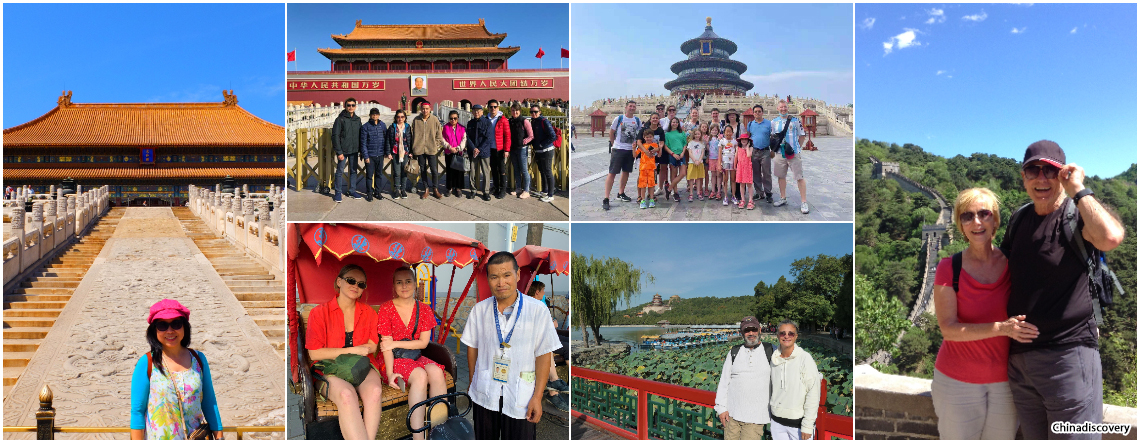
Our Delighted Customers in Beijing
Keep Reading About Forbidden City
- Forbidden City
- Forbidden City Travel Tips
- Forbidden City Facts
- Hall of Supreme Harmony
- Imperial Garden
- Nine-dragon Screen
- The Gallery of Clocks
- The Treasure Gallery
- Forbidden City Map
- How to Visit the Forbidden City
- Forbidden City Photography Tips
- Forbidden City Weather & Seasons
- How to Book Forbidden City Tickets
- How to Get to Forbidden City
- How to Transfer from Beijing Airports
Top Beijing Tours & Travel Guide
- Forbidden City Tours
- Popular Beijing Tours
- Great Wall Hiking Tours
- Beijing Visa Free Tours
- Beijing Layover Tours
- Tpo 6 Beijing Vacations
- Beijing Family Tours
- Beijing Travel Guide
- Beijing Travel Articles
- Great Wall Trip Planning Guide
- How to Plan a Beijing Trip
- Things to do in Beijing
- Top Experiences Recommended by LP
- Featured Activities in Beijing
- How to Get to & around Beijing
- Weather & Seasons in Beijing
- Beijing Maps
- Beijing 144/24 Hour Visa Free
- Recommended Hotels in Beijing
- Beijing Photo Gallery
- Top Beijing Food and Snacks
- Beijing Shopping
- Beijing Nightlife
- Beijing FAQs & Tips
Recommended Beijing Tours
Top 3 Beijing tours chosen by most customers to explore Beijing in the best way. Check the detailed itinerary, or tailor your own trip now with us.

8 Days Best of China Tour (Flight/Bullet Train Covered)
Beijing / Xian / Shanghai
Start planning your tailor-made holiday to China by contacting one of our specialists. Once inquired, you’ll get a response within 0.5~23.5 hours.
Customize a TripHave a question? Get answers from our travel experts or guests
- Your Question:
- Your Name:
- Your Email:
- Submit


























